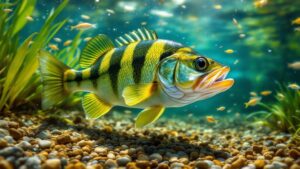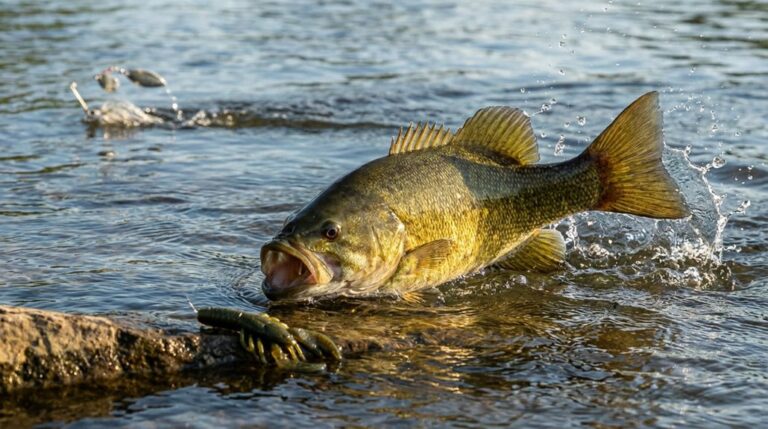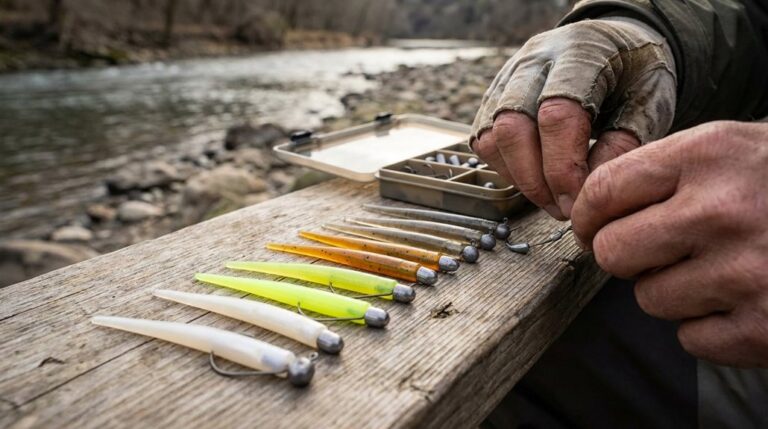You'll find that Suwannee bass are specialized predators with a strong preference for crayfish, which they can hunt more effectively than other bass species thanks to their wider throat structure. They'll target these crustaceans year-round, even during spawning season from February to May. While they'll also eat small fish and aquatic insects, crayfish remain their primary food source. Their unique feeding habits in shallow, fast-moving waters reveal fascinating survival adaptations worth exploring further.
Natural Prey Selection and Preferences
Although Suwannee bass share habitats with other species like largemouth bass, they've developed distinct dietary preferences that center primarily on crayfish consumption.
You'll find that these fish have specialized feeding habits that set them apart from their relatives, particularly in how they select their prey.
Their larger throat width enables them to target and consume bigger crayfish compared to other bass species, making this prey item their primary food source throughout the year.
While they'll also feed on various invertebrates and small fishes, crayfish remain the cornerstone of their diet, even during spawning season.
This dietary specialization has allowed Suwannee bass to thrive in their habitat alongside other species, as their focused feeding habits help reduce competition for food resources in shared environments.
Seasonal Feeding Patterns
During the changing seasons, Suwannee bass adjust their feeding patterns while maintaining crayfish as their primary food source.
You'll notice their diet shifts throughout the year, with young bass primarily targeting smaller prey while adults focus on larger forage resources.
Here's how their seasonal feeding patterns typically unfold:
- During spawning season (February to May), you'll find them heavily consuming crayfish, which peaks in April and May.
- Young Suwannee bass concentrate on aquatic insects and small crustaceans throughout their early development.
- Adult bass diversify their diet with small fishes while maintaining crayfish as their preferred prey.
You can observe how their throat width enables them to handle larger prey items, making crayfish an ideal food choice across seasons.
This adaptation helps them thrive alongside other species in their habitat.
Foraging Strategies and Techniques
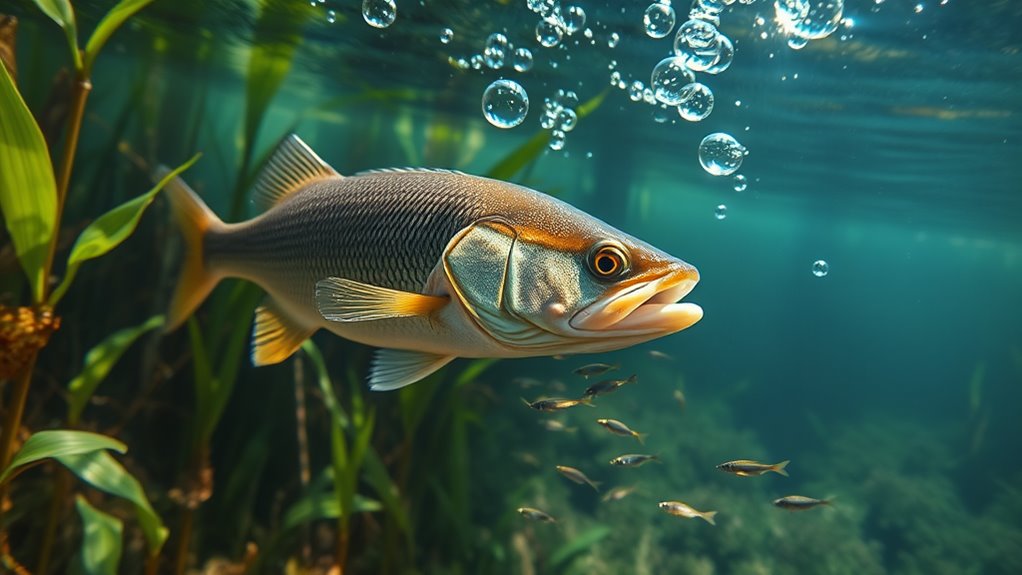
While stalking their prey in fast-moving shallow waters, Suwannee bass employ distinct foraging techniques that maximize their hunting success.
You'll find these fish positioning themselves strategically in fast-moving shallow areas, where they can effectively ambush their main food source: crayfish. Their specialized throat width allows them to consume larger prey items, making crayfish an ideal target.
During the spawning season, they'll adjust their foraging strategies to stay close to nesting sites, but they won't compromise their feeding habits.
When crayfish become scarce, you'll notice their opportunistic feeding behavior as they switch to alternative prey like small fish and other invertebrates.
Their diet composition reflects a smart balance between energy efficiency and prey availability, showing how well-adapted their foraging techniques are to their environment.
Feeding Competition With Other Species
In their shared aquatic environments, Suwannee bass face direct feeding competition with largemouth bass, yet maintain a competitive edge through their specialized diet. While both species compete for similar resources without habitat segregation, Suwannee bass have adapted to efficiently target crayfish as their primary food source.
You'll find these key factors affecting feeding competition between the species:
- Suwannee bass's wider throat structure allows them to consume larger crayfish more effectively than largemouth bass.
- Prey availability fluctuates seasonally, with competition intensifying during the February to May spawning season.
- The presence of diverse forage resources helps sustain both species despite their overlapping diets.
This dietary specialization enables Suwannee bass to thrive alongside their larger competitors, demonstrating how specialized feeding habits can reduce competition in shared habitats.
Impact of Habitat on Food Sources
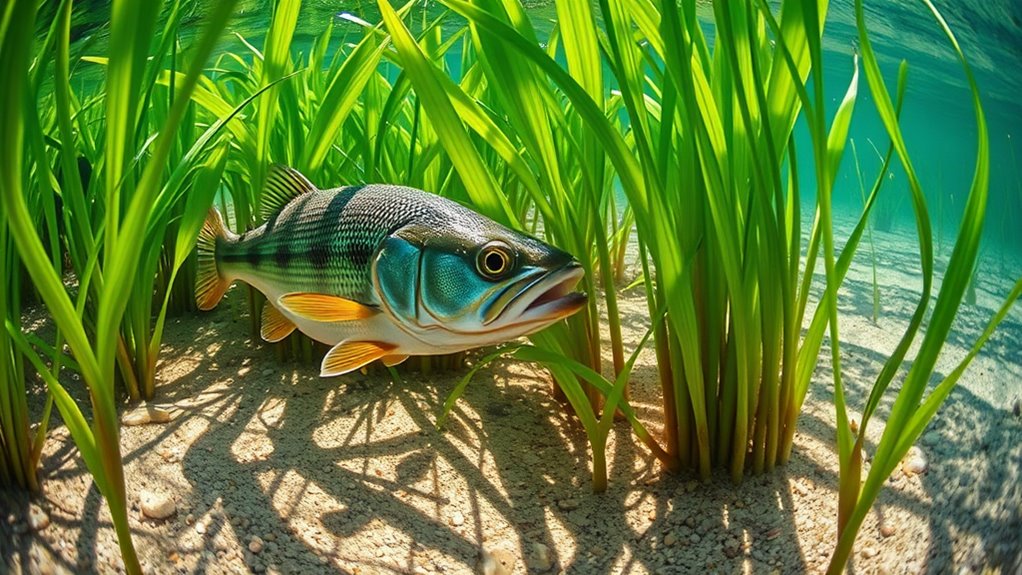
The fast-moving, shallow riverine habitats of Suwannee bass directly shape their feeding patterns and prey availability. You'll find that these fish thrive in environments where limestone structures and woody debris create ideal conditions for their primary prey, crayfish. Their habitat's characteristics don't just support their food sources but also enable them to coexist with largemouth bass despite similar dietary preferences.
| Habitat Feature | Impact on Food Sources |
|---|---|
| Fast currents | Attracts aquatic invertebrates |
| Limestone beds | Supports crayfish populations |
| Woody debris | Creates prey shelter areas |
| Shallow waters | Enables efficient hunting |
| Diverse structure | Promotes species coexistence |
The riverine ecosystem's diversity guarantees abundant food sources, with their preferred habitats providing the perfect environment for both predator and prey to flourish.
Growth and Development Through Diet
Growing Suwannee bass demonstrate a clear dietary progression that shapes their development from juveniles to adults.
You'll notice their dietary preferences evolve as they mature, with significant changes in forage resources affecting their size and growth.
The progression of their feeding habits follows three distinct stages:
- Young bass begin by consuming small aquatic insects and tiny crustaceans.
- As they grow larger, they shift to consuming more crayfish, which become their primary food source.
- Mature bass incorporate both crayfish and small fish into their diet, with their wider throat width enabling them to handle larger prey.
These dietary shifts directly influence their growth rates, and you'll find that larger Suwannee bass consistently target bigger prey items, maximizing their growth potential through efficient feeding strategies.
Frequently Asked Questions
What Is the Feeding Behavior of a Bass?
You'll find bass actively hunting for their prey, using ambush tactics to catch smaller fish. They're opportunistic feeders who'll strike at various food sources, including insects, crayfish, and other aquatic creatures.
What Do Florida Bass Eat?
You'll find Florida bass eating a variety of prey, including small fish, crayfish, frogs, insects, and even small birds. They're opportunistic feeders, and they'll strike at anything that fits in their mouth.
What Is the Diet of a Largemouth Bass?
You'll find that largemouth bass primarily feed on fish (57% of diet) and crayfish (33%). They're opportunistic predators, so they'll also eat invertebrates, amphibians, and birds when available, varying their diet seasonally.
What Is the Difference Between a Largemouth Bass and a Suwannee Bass?
You'll notice Suwannee bass are smaller and prefer crayfish, while largemouth bass grow larger and eat varied diets. They spawn differently too – Suwannee bass choose fast waters, but largemouth bass aren't as picky.
Final Thoughts
You've learned how Suwannee bass adapt their feeding habits throughout the seasons, targeting crayfish, small fish, and aquatic insects as their main prey. You'll notice they're opportunistic predators who've developed specialized foraging techniques in their limestone-based habitat. When you understand their diet and feeding patterns, you'll better appreciate how these habits directly impact their growth, survival, and interaction with other species in their ecosystem.

